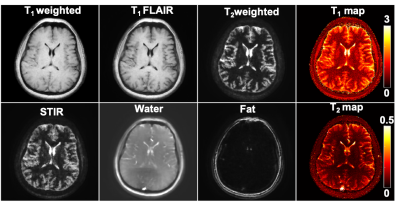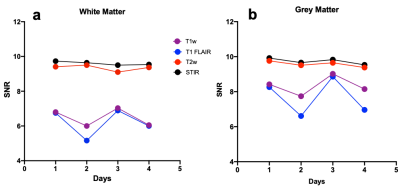pavan Poojar1,2, Enlin Qian1, and Sairam Geethanath 1,2
1Columbia Magnetic Resonance Research Center, Columbia University, New York, NY, United States, 2Dayananda Sagar College of Engineering, Bangalore, India
1Columbia Magnetic Resonance Research Center, Columbia University, New York, NY, United States, 2Dayananda Sagar College of Engineering, Bangalore, India
The narrow SNR range of 0.1 to 0.75 for white matter and 0.2 to 1.1 for grey matter shows that TMRF is repeatable. TMRF provides six contrasts and two maps in approximately 4 mins.

Figure 1: Representative images acquired using
tailored magnetic resonance fingerprinting (TMRF) which provides qualitative
and quantitative data simultaneously within ~4 minutes. This includes T1 weighted,
T1 fluid
attenuated inversion recovery (T1 FLAIR), T2 weighted, short tau inversion
recovery (STIR), water
and fat images. Quantitative
data include T1 and T2 maps. All images were acquired on in
vivo healthy
human brain on a
3T GE 750w scanner.
The reconstructed qualitative images were denoised using DL. The maps were generated
using DRONE method.

Figure 3: Signal to noise ratio (SNR) for the
four contrasts
(T1 weighted, T1 fluid attenuated inversion recovery (T1 FLAIR), T2
weighted, and
short tau
inversion recovery (STIR))
over a period of 4 days. All scans were performed on same in vivo
healthy human subject on a
3T GE 750w scanner.
The white matter (WM) and grey matter (GM) was segmented semi automatically using
3D slicer to get the (a) WM SNR and (b) GM SNR where different color
represents different contrasts. The SNRs were similar for all the four days.